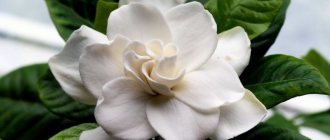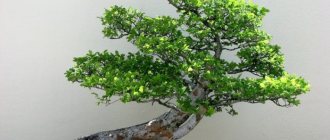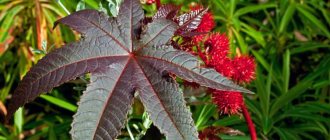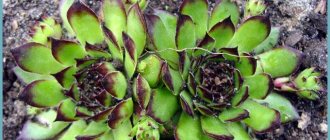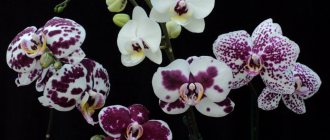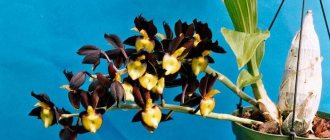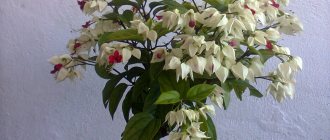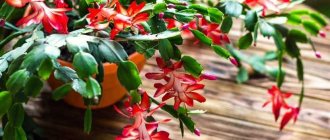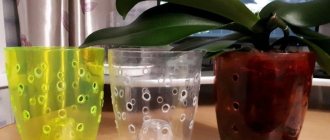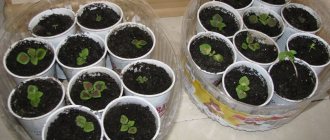We consider why the beautiful dicentra began to slowly displace roses, peonies and gladioli, why modern gardeners prefer to plant something new instead of the traditional one, which it brings to the appearance of the site. After reading the article, everyone will understand where it is best to plant dicentra, how to care for it, and how to combine the plant with other plantings.
Dicentra is beautiful - a new garden crop
Features of culture
The beautiful Dicentra is just beginning to win the hearts of ordinary gardeners. North America is considered its homeland. The flower came to Europe in the nineteenth century. Traders brought it from Japan. There the culture is very popular and has been elevated to the rank of a national treasure, like sakura.
A bright flower looks good against the backdrop of garden greenery
The beautiful Dicentra grows forty centimeters in height. Its peduncle is higher than the peduncle of other varieties; the shape of the buds is similar to a human heart. They gather in clusters, hang beautifully on the branches and emit a light, pleasant aroma that does not irritate the sense of smell, but only slightly excites its receptors. As they bloom, the flowers take on a soft pink or lavender color. It pleases the eye from the beginning of summer until the end of September.
Soft pink color
A beautiful dicentra in landscape design is used for group plantings, to decorate borders and driveways. It can be grown in free-standing flowerpots or in pots on windowsills.
Beautiful frame of stone paths
Dicentra in mixborder
Low varieties are ideal for creating mixborders; they look great next to kupena and lungwort. The combination of plants with tulips, tails and daffodils is effective. A beautiful dicentra can become a beautiful decoration for a rock garden. Try planting it and ferns nearby in the shade; you will see how easily you can arrange an area where other light-loving flowers do not grow.
The flower grows well among the stones
Original compositions are obtained from flower sections. They add color to the design of any special event. Flowers look great in photos, the pictures turn out bright and memorable. Therefore, today dicentra is actively used for floral decoration of various special events.
Dicentra looks very picturesque in the photo
Step-by-step instructions for planting dicentra rhizomes in open ground in spring and autumn
The rhizome will be able to take root normally and adapt to the garden in spring and autumn only if planted correctly. It is important to perform each step of the procedure correctly and in the correct sequence.
Therefore, step-by-step instructions for planting dicentras in open ground will come to the rescue:
- Dig a planting hole. The size of the hole is determined by the size of the rhizome: it should be 2 times wider and deeper than the rhizome or an earthen coma with it (if you sprouted planting material).
- It is useful to fill the pit with a nutritious dressing. To do this, humus (or compost), sand, rotted sawdust or garden soil are mixed in equal proportions. Fill the hole 1/2 full with nutrient soil. And on this dressing you should put a thin layer of ordinary soil (about 5 cm). If you have acidic soil at your dacha, then it is useful to also put wood ash or dolomite flour in the planting hole to deoxidize the soil.
- A couple of hours before transplanting, water the dicentra rhizome in the pot. If you just recently bought planting material and did not plant it in a pot for rooting, then it is useful to soak it in a solution of a growth and root formation stimulator, for example, Kornevin, Heteroauxin, before planting. Make the solution and process it according to the instructions!
- If the planting material is in a pot, then you need to carefully remove it, keeping the lump of earth intact, and simply transplant it into the hole using the transfer method.
Necessary conditions for growth and flowering
There are general provisions - rules of care that must be observed when growing any variety of dicentra. The flower is a shade-loving plant, so it does not do well in a sunlit area. It is better to plant it under trees in shaded areas. Then the flowering period will last longer, the color of the buds will be richer.
Feels better in the shade of the dicenter than in the sun
It is necessary to water the flower often, especially on hot days, but do not allow water to stagnate: the roots quickly begin to rot. In order for the beautiful dicentra to take root well, it is important to fill the holes with drainage before planting, and fill the remaining space with loose soil, half mixed with compost. Add limestone chips there, and the plant will reward you with good growth and lush flowering.
Lush flowering plant
Proper care
Dicentra is unpretentious; if everything was done correctly, it will grow well on its own. The main thing is to monitor watering: you cannot overdry the flower, you cannot overwater it. Constantly loosening the soil around the bush has a beneficial effect on growth. You need to start doing it from the moment the first green shoots appear.
Loosening the plant has a beneficial effect on its growth
Since the root system is located superficially, this must be done very carefully. Experienced gardeners use a trident to loosen the soil. If frosts occur in the spring, it is better to cover the young shoots with thick fabric. Otherwise they will die.
Protecting plants from frost with rags
See also: Catalog of popular house projects in chalet and eclectic styles
During flowering, it is important to promptly remove inflorescences that have already faded. It is also useful to cut off faded leaves, leaving neat stumps instead. Then the bush will look neat and very picturesque.
In winter, the plant remains in the ground. In northern latitudes it is covered with a thick layer of peat. In southern latitudes there is no need to do this, otherwise the flower will freeze and die.
The first flower feeding is done in early spring
The plant needs to be fed several times a season. The first fertilizing is done in early spring, then superphosphate fertilizer is applied to the soil. The second feeding is carried out during the appearance of the first flowers. Adding nitrogen-containing fertilizers to the soil will extend the flowering period of the bush. The last feeding is done in the fall. During this period, the roots are watered with infusion of manure.
Ready-made manure tincture
Reproduction
Practice shows that planting flower seeds does not allow you to get a beautiful flowering bush in the first year of growth. The seeds germinate poorly; if they take root, the dicentra begins to bloom only in the third year. Nurseries can afford to wait for this result, so they plant the seeds in the ground in late autumn, and then cover the plantation with plastic wrap.
Sowing seeds under film
Gardeners prefer to use other methods of propagation - division and cuttings. These operations are carried out every four years. If this is not done, the roots of the flower grow greatly and begin to rot.
Propagation of flowers by division
See also: Catalog of companies that specialize in the development and implementation of landscape design work
Root division can be done twice a year: either in early spring or late autumn, when the active phase of plant growth stops. It is carefully dug up, the roots are separated with a knife in such a way that three or four good large shoots remain in each new bush. Immediately after the operation, the divisions are planted in pre-prepared holes. Remember! A drainage layer must be laid on their bottom.
Drainage for planting
Note! If several separated bushes are placed in one hole at once, already in the first year of growth the plant will form into a lush flower.
Cuttings are done a little differently. The bush is undermined from the side of young shoots. The shoots are cut with a knife, including part of the root, and then immediately planted in the greenhouse and watered well. And when the plant takes root well (next spring), it is then dug up and transferred to open ground.
How a flower cutting is formed
Note! Dicentra beautiful has very poisonous roots - planting and care for this reason should only be done with rubber gloves. If you ignore the use of protective equipment, you can get burns on your hands. There are cases where such trauma led to damage to the central nervous system.
Personal protective equipment
In order for the plant to survive the winter, its branches need to be cut off in the fall, leaving small stumps five centimeters high on the surface of the soil. Experts recommend immediately treating the edges of the cut with a mixture of humus and peat.
A mixture of humus and peat
How to store dicentra rhizome and prepare it for planting
If you bought a perennial rhizome in advance, then it is advisable to think about storing planting material . Carefully inspect the purchase; if there are any rotten roots, they must be cut off with a clean knife. Immediately after purchase (and pruning, if done), you need to disinfect , namely, soak it in a fungicide solution according to the instructions, for example, Maxim summer resident, Fitosporin. After soaking, it is advisable to lubricate all cuts with brilliant green (“Diamond Green”).
Important! Do not store rhizomes in the refrigerator! There it can rot, or become susceptible to fungal diseases and mold.
Then the planting material is planted in a large pot for germination. The pot must be voluminous so that the rhizome fits freely into it. The container should also have drainage holes (in addition, it is recommended to place a 2-3 cm layer of expanded clay on the bottom of the pot). The soil should be loose and light.
When planting rhizomes in a pot, the sprouts (buds) should look straight up! The roots should lie straight down, they should not bend upward or sideways. If there are very long roots that do not fit freely into the pot, then they should be trimmed with a sharp knife.
At the time of storage until planting in open ground, the soil should be moderately moist, it should under no circumstances dry out or be wet (in the first case, the rhizome may die, in the second, it may become moldy or rot, and subsequently also die).
The germination temperature should be about 20 degrees Celsius or higher (the first two weeks after planting), during which time the rhizome actively takes root.
After this, you should move the pot to a cooler room, where the temperature is below 20 degrees, but not below 10.
If, after purchase, traces of rotting or mold were found on the rhizome, then after some time during germination it is necessary to water the pot with a solution of Fitosporin.
Dicentra should be stored in a pot until the optimal time for planting in open ground. When optimal weather arrives and you have time for the procedure, you must immediately plant the plant in the garden. If during germination the plant begins to form flower buds, then they must be plucked in order to preserve the plant’s resources for rooting in open ground.
Other plant varieties
In addition to the beautiful dicentra, there are other varieties. Dicentra splendid is considered more popular. She is the largest. An adult plant grows up to one and a half meters in height. The bush becomes lush and voluminous. In mid-summer it is completely covered with pink or white flowers. Such splendor looks very impressive, as evidenced by the following photo.
Dicentra is magnificent in all its glory
In landscape design, the magnificent dicentra is often used as a soloist. It is also planted in group plantings to form the background. With its help you can fill the farthest corners of the garden and cover the most unsightly places with it. If you plant bushes along the fence, they will tear down most of it.
Gorgeous dicentra bush – beautiful soloist
Dicentra superb looks like a fern. It is ideal for decorating alpine slides and for creating the lower tier of coniferous group plantings. Its inflorescences are pale pink. It perfectly refreshes the monotonous green range of evergreens.
Lush dicentra is excellent
Dicentra climbing - liana. It blooms with yellow buds and wraps itself around any obstacle, but its foliage does not completely hide the base. This species does not tolerate cold well, so it is difficult to grow in the northern climatic zones of Russia.
Dicentra climbing - creeping vine
Dicentra vagabond, on the contrary, tolerates cold well and thrives in mid-latitudes. It likes to settle in cracks between stones, on soils covered with crushed stone or sand, so it is better to plant the plant on natural slopes. It grows up to 20 cm in height, the roots are very short, located in the upper layers of the soil. The flowers are large, but there are not many of them. The photo shows what they look like during flowering (from July to September).
Dicentra vagrant tolerates cold well
Dicentra – photo
It seems that you can look at the dicentra inflorescences forever. So we couldn’t deny ourselves the pleasure and put together a large photo gallery!
Photo: distano.ru
Photo: sovkusom.ru
Photo: botanichka.ru Photo: martin-sad.ru
Photo: desktopbackground.org
Photo: pinterest.ru
Photo: nn.ru
Photo: floribunda.ru
Photo: sadoviycentr.ru
Photo: kurolevstvo.ru
Photo: oir.mobi Photo: distano.ru
Photo: sad-fialok.ru
Photo: saplings04.rf
Photo: stavropol7m.ru
Photo: oir.mobi
Photo: atlas.roslin.pl
Photo: distano.ru
Photo: nashgazon.com
Photo: artmaki.su
Photo: zen.yandex.ru
Photo: na-dache.pro
Photo: oir.mobi
Did you like the post? Subscribe to our channel in Yandex.Zen, it really helps us in our development!
2.Description
The genus Dicentra includes 8 species of attractive flowering herbaceous plants, including both perennial and annual ones. Perennial plants are often classified as subshrubs - they are the ones most often found in garden plots.
These plants have thick, weakly branched shoots bearing compound leaves on very long, thin petioles. The leaf segments are palmately dissected, green, with a glossy surface. The underside of the leaves may be a lighter shade.
Peduncles , depending on the species, can be either leafless, basal, or appear directly on the stems; their length and number of buds are also highly variable. If in some species short peduncles bear only 2 - 3 flowers, then in others gracefully curved flower shoots can bear several dozen buds.
↑ Up,
The shape of the flowers is extremely unusual - they are slightly flattened and resemble a broken heart with a crack at the bottom. From this crack protrudes a pair of spurs, often painted in a contrasting shade. The shades of the buds are most often in the white - red range; the length of the buds can reach 2 - 2.5 cm.
seed pods with small, dark seeds appear on the bushes
Interestingly, the varieties whose natural habitat is in Asia are heart-shaped. American plants differ in flower shape, but also have bilateral symmetry, which is quite rare in plants in nature.
↑ Up,
Height . Plant sizes vary greatly depending on the variety. While bush dicentras can maintain a compact shape and reach only 20 - 30 cm in height, many vine-like varieties and varieties grow up to 1 - 2 m.
↑ Up,
↑ Up,
